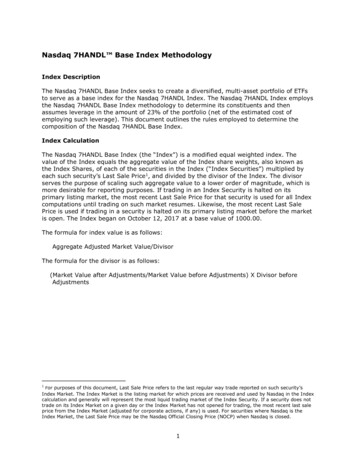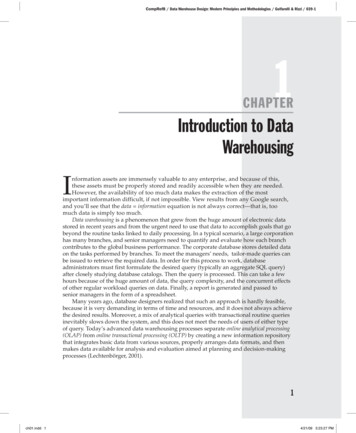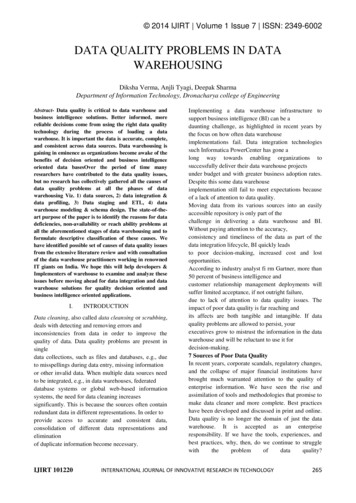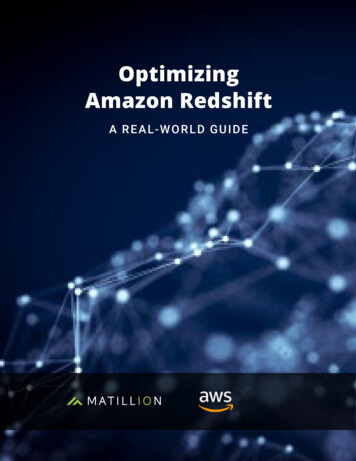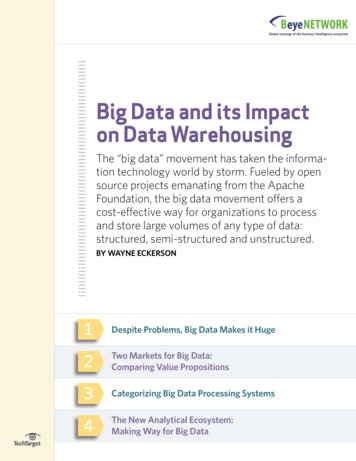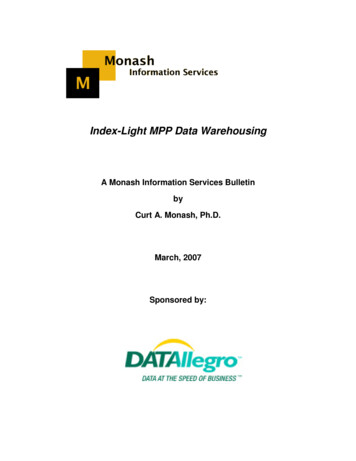
Transcription
Index-Light MPP Data WarehousingA Monash Information Services BulletinbyCurt A. Monash, Ph.D.March, 2007Sponsored by:
Index-Light MPP Data WarehousingPage 2AbstractDifferent DBMS arebest at differenttasks.Index-light MPPappliances excel atdata warehousing.A single relational database management system (RDBMS) can perform abroad variety of duties. It may even do them all pretty well. But for someuses, a special-purpose product can greatly outperform general-purposesystems. Complex data warehousing is such a task.For most data warehouses, market-leading general-purpose RDBMS aregood enough. But for complex queries against multi-terabyte datawarehouses, index-light MPP data warehouse appliances are a much moreefficient option. Offered by DATAllegro, Netezza, Teradata (if you use theterm “appliance” a bit loosely), and IBM (if you use the term “appliance”very loosely), these systems beat their index-heavy SMP counterparts onseveral major criteria:PerformancePrice/performanceConsistency of performanceAdministration costsMuch of thissuperiority stemsfrom three factors.The index-light MPP (Massively Parallel Processing) appliance story hingeson three technical factors:1. Shared-nothing MPP. Loosely-coupled systems are significantlycheaper than tightly-coupled ones, for the same level of rawcomponent performance.2. Reduced use of indices. By minimizing redundant references toinformation, index-light systems can store up to 7X less data thanindex-heavy ones. This produces enormous savings both in hardwareand in administrative costs.3. Avoidance of random disk reads. Disk rotation speeds have onlyimproved 12.5-fold in the past 50 years, making random disk lookupthe greatest constraint on conventional RDBMS performance. Indexlight systems largely evade this bottleneck.DATAllegro offers aprime example.DATAllegro offers what may be the archetype of the index-light MPPappliance strategy. A typical system contains multiple standard servers, eachresponsible for twelve standard disk drives, for a total installation in the tensof terabytes. (Indeed, as of DATAllegro V3, the servers and storage unitsare just standard Dell and EMC products respectively.) Data generallycomes off the disks in full table or partition scans, in 24-megabyte blocks,but you can use the functionality of Ingres if you want to. And the wholething is a lot faster and cheaper than conventional index-heavy alternatives. Monash Information Services, 2007. All rights reserved. Please do not quote in whole or in part without explicit permission. Alltrademarks (and tautologies) are the properties of their respective owners. Monash Information Services may be reached via www.monash.comor 978-266-1815 or via email to contact@monash.com. This independent white paper is sponsored by DATAllegro, Inc., who may be reachedvia www.datallegro.com
Index-Light MPP Data WarehousingPage 3Index-light MPP data warehousingOracle andMicrosoft havesimilar datawarehousestrategies.Oracle and Microsoft took similar approaches to data warehousing: Startwith solid OLTP database managers, and add in a bunch of features toaccelerate complex queries. The most important of these features arespecial-purpose index and data access options. Stars/snowflakes,materialized views, cubes – you name it, and one (in most cases both) ofthose vendors offers it. The basic idea of these various tactics is usuallysimilar – make certain assumptions about the queries that will be run, andaccelerate their execution by precomputing some of the steps in advance.*We call this classical approach index-heavy SMP, since it is generallypursued on tightly-coupled “shared-everything” SMP (Symmetric MultiProcessing) platforms.*Bitmaps/column indices are something of an exception to thisgeneralization, as are geospatial and full-text indices.Teradata, IBM,DATAllegro, andNetezza favor adifferent approach.While the Oracle/Microsoft approach suffices for most data warehouses, arival strategy has had great success at the high end of the market: index-lightMPP/appliance. Its key elements include:Dedicated “appliances” rather than general-purpose computers.*“Shared-nothing” MPP (Massively Parallel Processing) rather than“shared-everything” SMP.Limited use of complex indexing, relying instead on the raw speed inexecuting basic functionality.Teradata is the long-time standard-bearer for this approach, but in recentyears has gotten a lot of company. Upstarts DATAllegro and Netezza followa purer form of the strategy than Teradata does, and IBM is moving evermore toward an index-light MPP appliance approach as well.*Reasonable people can disagree as to what really does or doesn’t constitutea computing appliance. We take a rather expansive view of the term – ifsomething is a single-purpose computer with pre-installed software, we’reinclined to call it an “appliance.”Index-light MPPappliances havemultipleadvantages:Cheaper hardware, The index-light MPP appliance approach to data warehousing has somecompelling advantages over the OLTP-plus strategy. These include:Cheaper hardware. Integrated hardware is expensive to scale. So ifone can divide a job among N modules, that’s usually much cheaperthan using one tightly integrated system approximately N times aspowerful. Monash Information Services, 2007. All rights reserved. Please do not quote in whole or in part without explicit permission. Alltrademarks (and tautologies) are the properties of their respective owners. Monash Information Services may be reached via www.monash.comor 978-266-1815 or via email to contact@monash.com. This independent white paper is sponsored by DATAllegro, Inc., who may be reachedvia www.datallegro.com
Index-Light MPP Data WarehousingPage 4 smallerdatabase sizes, Smaller databases. Indices consume lots of disk space, sometimes 610 times as much as the raw data itself. This is a huge advantage forthe index-light approach. less overhead, Less overhead. Not only do indices have to be stored on disk, theyhave to retrieved, maintained, and so on. While the purpose ofindices is to reduce total processing, too often they have the oppositeeffect. loweradministrativecosts, Less administration. Indices don’t just make work for computers.They also make work for people. A large fraction of the DBA(DataBase Administrator) workload consists of managing thecomplex indices needed for analytical queries. Oracle, Microsoft,and for that matter IBM make huge efforts to offer ever-betterautomation. Even so, conventional data warehouses are a fullemployment program for expensive DBAs. more consistentresponse times, Consistent response times. In conventional index-heavy datawarehouses, the performance of a query depends greatly on whetherthe appropriate special index happens to have already been built toaccelerate it. In index-light MPP appliances, performance is moreeven. and better actualperformance.Better performance. And those consistent responses are fast. MPPappliances commonly outperform conventional warehouses even onqueries the latter are carefully tuned for, and blow them away onothers. What’s more, this performance comes at much lower totalcost of ownership.Shared-nothing MPPParallel processingis inherently morecost-effective.There are two ways to make more powerful computers:1. Use more powerful parts – processors, disk drives, etc.2. Just use more parts of the same power.Of the two, the more-parts strategy is much more cost-effective. Smaller*parts are much more economical, since the bigger the part, the harder andmore costly it is to avoid defects, in manufacturing and initial design alike.Consequently, all high-end computers rely on some kind of parallelprocessing.*As measured in terms of capacity, transistor count, etc., not physical size. Monash Information Services, 2007. All rights reserved. Please do not quote in whole or in part without explicit permission. Alltrademarks (and tautologies) are the properties of their respective owners. Monash Information Services may be reached via www.monash.comor 978-266-1815 or via email to contact@monash.com. This independent white paper is sponsored by DATAllegro, Inc., who may be reachedvia www.datallegro.com
Index-Light MPP Data WarehousingPage 5There are two mainkinds of parallelprocessing.There are two main kinds of parallel processing: Shared-everything andshared-nothing. In shared-everything systems, multiple processors address acommon pool of memory – RAM and disk alike. In shared-nothing systems,there is a much looser coupling of components, which each processorcontrolling its own RAM and disk as it would in a stand-alone computer.While the two terms are not wholly equivalent, as a practical matter sharedeverything systems are typically also SMP (Symmetric Multi-Processing),and SMP machines are typically shared-everything. Similarly, sharednothing systems are inherently MPP (Massively Parallel Processing), whileMPP systems are usually shared-nothing.Shared-everythingSMP doesn’t scalewell.When parallel processing became common in the 1990s, shared-everythingSMP won out over MPP, for one compelling reason – existing softwaredidn’t need to be rewritten. However, SMP has major problems withscalability, in at least two ways. One is a general problem: As eachprocessor keeps track of what the others are doing, SMP overhead increasesexponentially with the number of processors. Another is more databasespecific: Shared-everything storage bandwidth has trouble keeping up withthe data flows that dozens or hundreds of processors demand. Consequently,MPP always played a role in high-end data warehousing, primarily viaTeradata.Shared-nothingMPP datawarehousing iswell-established.By now, MPP has gained footholds in various areas of high-end businesscomputing, commonly referred to by names such as “grid,” “virtualization,”or just “cluster.” Its greatest success – research/scientific uses perhaps aside– continues to come in the area of complex data warehousing. Looking atmarket share, two of the top four data warehouse software providers favor anMPP approach (Teradata and IBM, with the others being Oracle andMicrosoft). And if one expands the list to include top technology contenderswith lower market shares, MPP providers still account for half or so of thenames.Common MPPdesign elementsinclude:Index-light MPP data warehouse appliance (or software) products reflect avariety of design choices and feature sets. But as one examines the variousofferings, certain themes keep recurring:Hash partitioning, Hash partitioning. A hash is a function that takes a data value andcalculates an address or key, almost uniquely (100% uniqueness isusually neither feasible nor necessary). In hash partitioning, a hashis used to spread data evenly across MPP nodes. Thus, the work ofretrieving data is also typically spread evenly among the nodes, formaximum performance. In DATAllegro systems, data is almostalways hash partitioned. heavy use ofHash joins. One of the best ways to join two tables in a relational Monash Information Services, 2007. All rights reserved. Please do not quote in whole or in part without explicit permission. Alltrademarks (and tautologies) are the properties of their respective owners. Monash Information Services may be reached via www.monash.comor 978-266-1815 or via email to contact@monash.com. This independent white paper is sponsored by DATAllegro, Inc., who may be reachedvia www.datallegro.com
Index-Light MPP Data WarehousingPage 6hash joins, database is to hash on the join keys in each of them and comparevalues. When the data happens to be pre-hashed, these hash joins areeven more efficient. If hash partition keys are well chosen, thishappy circumstance can occur a significant fraction of the time. InDATAllegro’s systems, hash is the join algorithm of choice. selective use ofindexing, Limited indexing. Indices serve two main functions in relationaldatabases – they tell you where to find particular pieces of data, andthey precalculate some of the intermediate results needed for certaintable joins. Limited-index MPP appliances willingly forgo most ofthese advantages. Rather than slowly finding exactly the right data,they read larger amounts of data extremely quickly. and fast internode transport.Fast node-to-node data transport. MPP data warehouses requiremoving a lot of data from disk to processor, and then among variousprocessing nodes. As a result, even MPP providers that otherwiseuse fairly standard hardware and software underpinnings commonlydo something “extra” to speed up this transport. DATAllegro, forexample, makes aggressive use of Infiniband, currently via Ciscoboxes.Limiting Database ExpansionRDBMS usuallyrely on indices tofind rows.Traditional relational database managers store data in rows. For each table,they maintain indices on one or more columns or column combinations – i.e.,keys. For each value of the key, the index stores a list of rows in which thatvalue can be found. More precisely, it will commonly store the address of ablock of data in which the specific desired rows are located.Complex indexingleads to databaseexpansion.If you index on every column, you in effect reproduce all the information ina database, plus you store row/block addresses over and over again. Naively,therefore, one might think that the most aggressive possible index wouldincrease database size by a factor of 2-3X over what’s needed just to storethe raw data itself. But it gets worse than that. For example, precalculatedaggregates can defeat sparsity compression. And precalculated joins canrequire the maintenance of views that are larger than the underlying tablesthemselves. As a result, 6-9X factors of database expansion are not unusual,and more than 10X is not unheard of. And if you get into non-relationalMOLAP (Multi-Dimensional OnLine Analytic Processing) systems –something we generally do not recommend -- expansion can be much worseyet.Expansion causesstorage andThe most obvious cost of expansion is disk – if you have more data, youhave to pay for platters to store it. But there are human costs as well. All Monash Information Services, 2007. All rights reserved. Please do not quote in whole or in part without explicit permission. Alltrademarks (and tautologies) are the properties of their respective owners. Monash Information Services may be reached via www.monash.comor 978-266-1815 or via email to contact@monash.com. This independent white paper is sponsored by DATAllegro, Inc., who may be reachedvia www.datallegro.com
Index-Light MPP Data WarehousingPage 7administrationcosts.those indices have to be created and maintained. Two decades after thesuccessful commercialization of RDBMS, tuning them is still a hit-or-missproposition. Even if you have state-of-the-art toolsets, managing aconventional data warehouse is a highly labor-intensive operation.Index-free datawarehouses arenow realistic.Increasingly, it is turning out that those expensive indices aren’t necessaryafter all!* In some cases, such as most DATAllegro installations, tables arestored with no index whatsoever. This is not as outlandish as it may firstsound. When a table is used in a join, it is common to read the whole thinginto memory anyway. Range partitioning can also play a lot of the indices’traditional role in expediting data retrieval. Nonetheless, index-freestrategies are pursued mainly on MPP data warehouse appliances carefullydesigned for super-fast table scans.*Why that’s happening now is explained in the next section.In other cases,lightweight indexingcan suffice.That said – while index-free strategies work for some applications, in othersindices are needed no matter who your vendor is. Some data warehouseapplications, for example, follow up complex queries with simpletransactions – and if you’re doing transactions, generally it really is best tohave a path directly to an individual record. Fortunately, the majority ofMPP data warehouse appliance vendors offer full DBMS capabilities.DATAllegro, for example, incorporates the RDBMS Ingres, which is usedfor many demanding transactional applications by customers such as theNew York Stock Exchange.Sequential accessMost aspects ofcomputer hardwareimproveexponentially.By most measures, computing power doubles every couple of years.Whether you’re looking at CPU (Central Processing Unit) speed, RAM(Random Access Memory) capacity, RAM capacity per unit of cost, diskstorage density, network throughput, or some other similar metric – all ofthese are subject to some version of Moore’s Law. That is, they improve bya factor of 2 every couple of years or so. For example, in a little over twodecades, the standard size of a PC hard disk has increased from 10megabytes to 80 or 160 gigabytes, for a total of 13 or 14 doublings.Note: PCs and servers use substantially similar components these days, soit’s appropriate to use numbers from either class of machine.Disk rotation speedis a hugeexception.But there’s one huge exception to this trend. The rotational speed of disks islimited by their tendency to “go aerodynamic” – i.e., to literally fly off of thespindle. Hence this speed has grown only 12.5-fold in a half a century, from1,200 revolutions per minute in 1956 to 15,000 RPM today. Monash Information Services, 2007. All rights reserved. Please do not quote in whole or in part without explicit permission. Alltrademarks (and tautologies) are the properties of their respective owners. Monash Information Services may be reached via www.monash.comor 978-266-1815 or via email to contact@monash.com. This independent white paper is sponsored by DATAllegro, Inc., who may be reachedvia www.datallegro.com
Index-Light MPP Data WarehousingPage 8Disk accessdominates RDBMSresponse times.The time to randomly access a disk is closely related to disk rotation speed.A 15,000 RPM disk makes half a rotation every two milliseconds (ms),which is thus the absolute floor on average disk access times; 5-6 ms is amore realistic figure for the fastest disks, ranging up to 15 ms for cheaperones. Even the low end is about a million times longer than raw RAM seektimes, which have declined to just a few nanoseconds. Therefore, nothingthat happens in silicon is nearly as important to DBMS performance as theraw speed of getting data on and off of disk.Random diskaccess can bepainfully slow.Traditional RDBMS use block sizes of 32K-128K. The fastest drives on themarket have transfer rates in the 100-300 MB/sec range, depending on whois doing the measuring. If the blocks could be read with no random accesslatency, that would be in the range of 800-10,000 blocks/second. But even ifreading were instantaneous, random seek latency limits that to a mere 70250/second or so. And that’s even before taking into account the fact that –even with state-of-the-art caching -- an index-based lookup can make severaldisk reads for each row eventually found.Table scans can befaster than indexbased selection.Sequential table scans, however, can actually read data at close to thetheoretically maximum speed. So even though they have to retrieve muchmore data at a time, appliances that rely on sequential, index-light processingreally can be faster than conventional index-heavy RDBMS. And while ourargument so far has been pure theory, customer experience has shown thatit’s true in practice as well.DATAllegro’s MPP data warehouse appliancesDATAllegro is aposter child formodern MPP datawarehousing.DATAllegro is a poster child for index-light MPP data warehousing, withenough customer success and competitive proof-of-concept wins to validateits approach. Key aspects of DATAllegro’s technology include:Unconventional use of standard computer hardware.A full-featured standard DBMS.Proprietary parallel data management built on top of the standardDBMS.Optimization for sequential rather than random data access.It used to offerType 1 appliances.DATAllegro’s hardware strategy resembles that of security and antispamappliance makers. Even when it still made its own hardware, it usedconventional processors, disks, and so on, except in two areas whereappliance vendors commonly deviate from computing norms – networkingand encryption. In those areas, it still used standard parts; but they wereones rarely found in general-purpose computers. This is an example of whatwe call “Type 1” appliances. Monash Information Services, 2007. All rights reserved. Please do not quote in whole or in part without explicit permission. Alltrademarks (and tautologies) are the properties of their respective owners. Monash Information Services may be reached via www.monash.comor 978-266-1815 or via email to contact@monash.com. This independent white paper is sponsored by DATAllegro, Inc., who may be reachedvia www.datallegro.com
Index-Light MPP Data WarehousingPage 9Now it offers Type2 systems.As of its latest product generation, however – DATAllegro V3 –DATAllegro has switched to the Type 2 camp. That is, its appliances useutterly standard hardware, albeit in prespecified configurations. The mainelements are Dell servers, EMC storage, and Cisco Infiniband boxes. Unlikesome appliance vendors, DATAllegro also uses a standard operating system– 64-bit CentOS Linux. Besides the use of Infiniband, DATAllegro’s mostunusual architectural choice is that the disks within each EMC storage unitare split into two RAID1 arrays of six disks each, with each RAID arraybeing dedicated to one Dell server.Included is a fullfeatured RDBMS The core DBMS for DATAllegro’s appliances is Ingres. Once a closecompetitor to Oracle, Ingres languished for various business reasons, and isnow open sourced. In essence, it’s a state-of-the-art 1990s RDBMS, withtransactional capabilities robust enough for just about any “operational datawarehouse” use. Particularly important are range partitioning capabilities,which commonly obviate the need to do full table scans. which has beenmodified forparallelization.Ingres itself isn’t an MPP system. But DATAllegro has modified andextended it for massively parallel operation. Parts of this work seemstraightforward; indeed, there’s no need to change query parsing at all, whileoptimizer modifications in essence just memorialize the changes in theexecution structure. Rather, the hard part lies in query execution,specifically in moving data around. The biggest issue is the management ofintermediate result sets, and distributing them to the proper node. If joinswere only done two tables at a time, MPP probably would have been thestandard DBMS industry architecture a decade ago.The key is how thepieces fit together.Arguably, the parallelization piece is the only major part of DATAllegro’stechnology that’s proprietary at all. Rather, the big technicalaccomplishment lies in how it all fits together. MPP exploits partsmanufacturing efficiencies. Sequential reads solve the disk speed bottleneck.Fast data transport takes the sting from MPP. Cheap CPUs slice through thelarge rowsets brought in by the sequential reads. Yes, MPP software designis hard. But DATAllegro and other vendors have shown how to do it. Atleast for high-end data warehousing, shared-everything SMP is now anobsolete technology. Monash Information Services, 2007. All rights reserved. Please do not quote in whole or in part without explicit permission. Alltrademarks (and tautologies) are the properties of their respective owners. Monash Information Services may be reached via www.monash.comor 978-266-1815 or via email to contact@monash.com. This independent white paper is sponsored by DATAllegro, Inc., who may be reachedvia www.datallegro.com
Index-Light MPP Data WarehousingPage 10About the AuthorFor more than a quarter-century, Curt Monash has been a leading analyst of and strategic advisorto the software industry. Praised by Lawrence J. Ellison for his "unmatched insight intotechnology and marketplace trends," Curt was the software/services industry's #1 ranked stockanalyst while at PaineWebber, Inc., where he served as a First Vice President until 1987. Since1990 he has owned and operated Monash Information Services, a highly acclaimed technologyanalysis firm focused on enterprise software. He has been extensively published and quoted inthe technology and general business press, and has been a regular columnist for ApplicationDevelopment Trends, Software Magazine, and Computerworld. To get Curt’s latest research,please see www.monash.com/feed.php .Prior to his business career, Curt earned a Ph.D. in Mathematics (Game Theory) from HarvardUniversity at the age of 19. He has held faculty positions in mathematics, economics and publicpolicy at Harvard, Yale, and Suffolk Universities. For more information please seewww.monash.com .About the SponsorDATAllegro entered the market in 2003 with the goal of making data warehousing moreaffordable and more valuable to companies than any other offering. After researching thetechnology available at that time, DATAllegro invented a new way of distributing data across anumber of servers and then running queries in parallel. Integrated with hardware, storage and adatabase, the end result was a data warehouse appliance that represented a true breakthrough indata warehouse price/performance. Instead of paying millions for a traditional system,companies could achieve a 10-100x improvement in query performance, at a fraction of the costof other providers.The company can be reached via www.datallegro.com .Further ReadingFor more research on the subjects of this white paper, please see www.dbms2.com , base-management-systems/rolap/. Future researchmay be found via the free RSS and e-mail subscriptions at http://www.monash.com/feed.php . Monash Information Services, 2007. All rights reserved. Please do not quote in whole or in part without explicit permission. Alltrademarks (and tautologies) are the properties of their respective owners. Monash Information Services may be reached via www.monash.comor 978-266-1815 or via email to contact@monash.com. This independent white paper is sponsored by DATAllegro, Inc., who may be reachedvia www.datallegro.com
MPP data warehousing is well-established. By now, MPP has gained footholds in various areas of high-end business computing, commonly referred to by names such as "grid," "virtualization," or just "cluster." Its greatest success - research/scientific uses perhaps aside - continues to come in the area of complex data warehousing.

